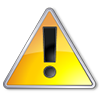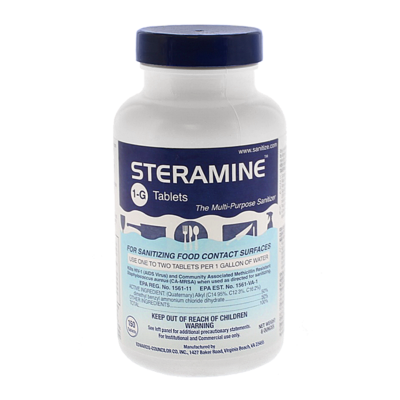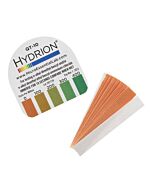Steramine Multi-Purpose Sanitizer
- Multi-purpose sanitizer that meets the public health criteria of the Environmental Protection Agency
- Contains quaternary ammonium, a widely used antimicrobial agent
- Also a cationic surfactant to clean and sanitize your dive equipment in one step
- Non-irritating to the hands, non-corrosive to metals, non-staining, and odorless
- One 150 tablet bottle makes 75 to 150 gallons of sanitizer
Steramine Multi-Purpose Sanitizer
Steramine is an antimicrobial agent for use on hard non-porous surfaces against a wide range of pathogens including HIV-1 and CA-MRSA. The active ingredient in Steramine, quaternary ammonium, is on the EPA list of antimicrobial agents that meet their criteria for use against SARS-CoV-2 (COVID-19 novel coronavirus). Steramine has a long history of use that meets the public health and regulatory criteria of the Environmental Protection Agency (EPA), U.S. Public Health Service (USPHS), and the U.S. Food and Drug Administration (FDA).
Steramine is also a cationic surfactant to both clean and sanitize your dive equipment in one step. Unlike bleach or strong detergents, Steramine sanitizing solutions are non-irritating to the hands, non-corrosive to metals, non-staining, and odorless. Among the Dive Gear Express team members, our many years of experience with Steramine has demonstrated the sanitizer has no compatibility issues with any of the materials commonly seen in diving equipment such as rubber, silicone, neoprene, plastics, technical fabrics, mask optical coatings, chrome plated brass, aluminum, and stainless steel.
We offer a container of 150 tablets making a total of { 75 to 150 gal | 284 to 568 L } of sanitizer depending on the desired concentration of 200 ppm for soaking or 400 ppm for spraying. The dry tablets themselves do not have a shelf life (the date on the bottle is date of manufacture not expiry) because the antimicrobial agent is only activated once mixed with water.
Directions: Use ordinary drinking water to prepare your sanitizing solution. Mix one tablet (for 200 ppm) or two tablets (for 400 ppm) with one gallon of water. (Steramine tablets can be slow to dissolve in cold water, so if you need to accelerate the process then dissolve the tablets in a cup of warm tap water and then pour that into the rest of the cold water.) Do not mix with other detergents or soaps. Dive Gear Express recommends the stronger 400 ppm concentration if you are spraying and the 200 ppm concentration if you are soaking. Follow the recommendations from the equipment manufacturer for cleaning your dive gear, allowing the wet solution to contact surfaces to be sanitized for at least 1 minute. You should not soak dive equipment in hot water and we do not recommend prolonged (i.e. multi-hour) soaking. Steramine leaves no residue, but we recommend rinsing after use. Unless you use a test strip to validate the solution strength, you should prepare a fresh sanitizing solution daily or if the solution becomes diluted or soiled.
| Brand | Edwards-Councilor Co, Inc. |
|---|---|
| SKU | EC-1G150 |
| Weight | 0.750000 |
Customer Reviews
 WARNING
WARNING
Our products are intended for use in SCUBA diving related applications; they are not intended for use in medical, aerospace, or industrial applications. Purchases for use in non-diving applications are not qualified for return or refund. We are not able to supply certificates of conformance to any specific requirements or specifications such as Mil-Spec, OSHA, ISO or CE standards.
Sanitizers, Disinfectants, Antiseptics and Your Rebreather & Regulators
Over the years, rebreather divers have used many products as breathing loop cleaners, often with questionable safety, uncertain efficacy, and poor material compatibility. Some products recommended by non-US rebreather manufacturers are not available in the US because they do not meet the regulatory criteria of the Environmental Protection Agency (EPA), U.S. Public Health Service (USPHS), and the U.S. Food and Drug Administration (FDA).
Dive Gear Express has recommended two different types of antimicrobial agents for cleaning SCUBA equipment: RelyOn®, a disinfectant, and later Steramine™, a sanitizer. RelyOn (sold outside the US under the name Virkon) and Steramine are both suitable for use in the food service industry where they are proven safe and effective. (The assumption being if they are safe and effective under conditions of repeated exposure to food service workers, are not harmful to equipment, and incidental amounts that get in the food are benign then they should be suitable for cleaning dive gear.) The actual difference between the terms disinfectant and sanitizer is largely a matter of legal definitions based on which government agency is regulating what industry.
- A disinfectant is a chemical that completely destroys all specific test organisms on non-living surfaces within 10 minutes under conditions of the AOAC Use Dilution Test. The health care industry is most interested in disinfectants. A dilute solution of sodium hypochlorite (aka 'liquid bleach') is widely used as a disinfectant in health care and common household applications. However, NEVER use bleach to disinfect SCUBA gear because it has unsatisfactory compatibility with some seal materials commonly used in rebreathers and regulators.
- A sanitizer is a chemical that reduces the number of microorganisms on non-living surfaces to a safe level. Sanitizers are required to kill 99.999 percent of the specific test organisms present within 30 seconds under conditions of the Weber & Black Test. The food service industry is most interested in sanitizers, particularly because they are fast acting.
- An antiseptic is applied to living skin or tissue to prevent infection. Antiseptics are not as suitable for cleaning rebreathers because in this application they are significantly less effective and some may have material compatibility concerns. There are also concerns about unknown safety of antiseptic residue that might remain in a regulator second stage or CCR breathing loop after cleaning.
A very limited study of rebreather disinfection concluded soaking with Steramine is the most effective antimicrobial agent and cleaning method among those studied. What the study clearly demonstrated is that cleaning of equipment with an effective antimicrobial agent is required and that simply rinsing with ordinary tap water is neither sufficient nor effective.




